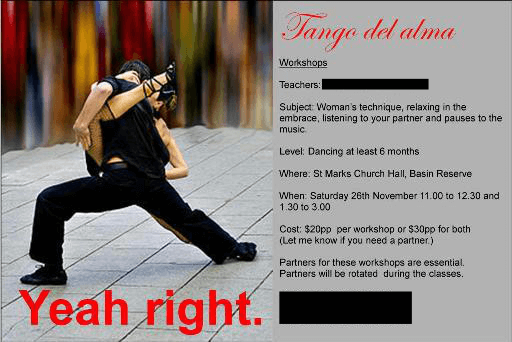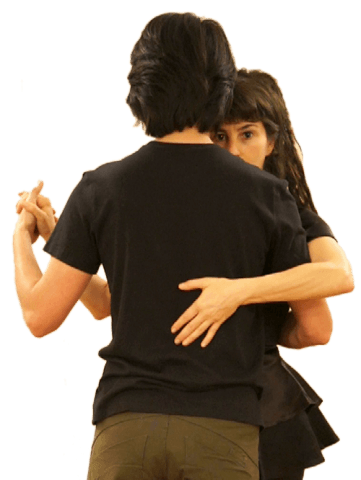I had to do it again, this time to my maestro, and it was painful. He had written me an email, in English, for advice on organizing a tour to New Zealand. This was such a beautiful sparkling possibility for my students. I was thrilled! But I had to tell him the truth. I wrote back in Castellano:
It doesn’t matter how much time you spend dancing in close embrace, or what words you use about yourself, if people see in a video or in the dance floor that for one moment you use open embrace they will insist you are Nuevo, and the majority of the people in this part of the world will then believe that your technique has no relevance to their dance.
As I’ve written in my previous post on Nuevo Tango the term is not used in Buenos Aires any more, nor could you distinguish which milonga you are in based on the embrace, the performers, which moves are used, or the music. This is because both the founders of Nuevo Tango and the community at large agree that they did not invent one single new movement. The founders claim only to have developed a language to describe tango movements and to have applied concepts of dance kinesiology to Argentine Tango, nothing more. Because of this recognition, younger dancers, with appropriate humility, don’t claim to do anything “new”. [Also see Tango Nuevo, a term coined by Petróleo in the 1940s…, my summary of Carolyn Merritt’s excellent dissertation on the subject.]
Once again: There are no “new” tango moves, none, not one!
I am sure that my maestro would respond to this idea of fixed styles by saying something to the effect of “I do not have a style of tango, except what is my dance, my expression, and it can be different every day, with my mood, my feeling for the music…”
And I know that no matter how many times I’ve had this discussion in New Zealand and Australia, and no matter how much time I spend dancing in a very traditional way, people continue to label me as “Nuevo”, as they did my brilliant friend, Sebastián Arrúa, whose first tour to New Zealand I organized.

And it goes beyond labeling. People regularly make derogatory comments. To the right is an actual advertisement for a New Zealand “milonguero” class, which attempts to deprecate Nuevo Tango. (I have obscured identifying information about the teachers.)
It’s extremely frustrating for me and the people I work with, because the technique we teach facilitates every kind of movement made in tango in all “styles“. We teach students to create a powerful and subtle connection from the floor through both bodies. This enables followers to become light and responsive and frees leaders to be creative. Using this connection has nothing to do with fancy movements or which embrace you are in.
And the so-called “milongueros” accuse us of forsaking connection for “acrobatics”.
Nothing can be further from the truth. The pleasure of a big voleo or a big gancho is to feel the connection ripple through both bodies like a whip crack. That’s the only reason to do it. And it requires concentration, physical skill, the leader’s trust in the follower, and the follower’s surrender no less than (and perhaps more than) any other experience of tango. This is the same pleasure that can be had through a step as tiny as a change of foot in close embrace — it seems to suspend in the air while the partners melt out of time and into each other. It’s the same commitment to connection, and the same physical skills.
I enjoy both. Equally.
People invite me to dance and start apologizing that they don’t dance in open embrace or they don’t dance tango nuevo. I could care less what moves they do or which embrace they want to use. I am looking for that kind of connection and their willingness to use it and me to play with the music, in any steps they want. I shrug.
The Buenos Aires perspective: “Tango Nuevo doesn’t exist” and the NZ/AU perspective “There are styles of Argentine Tango and every dancer can be categorized into one of them” are talking past each other. No amount of explaining from either side seems to affect the view of the other side. Argentine dancers (and anybody who spends time there) will be pissed off at being unfairly and inaccurately categorized. People here seem unable to relate to tango without grounding themselves in these categories.
I have considered three possible tactics for dealing with the Nuevo Tango accusation:
- Continue insisting “there is no such thing as nuevo tango, therefore I don’t do it.”
- Embrace “acrobatic tango nuevo” and promote it. Maybe it will help get tango out of its clichés and attract energetic and open-minded people into the dance.
- Stop the denial and talk about what seems different about the way my maestros and I dance.
While continuing with #1 and #2, this post is my first attempt at #3.
People here think they are seeing something different when they watch what they call Nuevo Tango. Let’s leave aside bad, unconnected, ganchos that none of us want to feel or see. And let’s start out already recognizing that nothing I say below wasn’t done on the dance floor plenty of times long before the era of Nuevo Tango.
What do we see?
- expansion of the dynamic range, heightened contrast between high and low, big and small steps
- expansion of the “open” position so the partners are, at times, quite far from each other, and the connection is not always through the front center of the chests
- softening of the embrace so that the “closed” position also takes varied positions.
- softening and elasticity of the bodies becomes visible, shoulders, hip, and knee joints are relaxed, creating more fluid, soft movement
- visible independence and strength of the follower’s axis looks more athletic
- more muscle, longer suspension, deeper compression into the floor
- increased use of contra power, not only in positions where the follower’s response is inevitable, but in positions where she must meet it with corresponding compression
As I typed each line I was fully aware that all of these things are part of all tango, done well. The difference, when these become visible in Nuevo Tango, is a matter of degree.
Now, if I can theorize: What distinguishes Nuevo Tango dancing:
- Drawing on dance kinesiology, Nuevo Tango followers developed a more independent and muscular axis, more dynamic matching of the leader’s power, and a more soft, fluid, flexible, and free free leg which is allowed to move to its maximum extension in the direction of the leader’s power.
- By searching for more dramatic movements to express Nuevo Tango music, leaders expanded the dynamic range by softening their joints, deepening their compression into the floor, extending their steps longer and stronger, and exploring the embrace as a continuum.
It’s disingenuous to pretend that this is merely a matter of style. It takes more muscle, a much higher level of skill on the part of the follower, and much more trust from the leader. The leader can’t simply hold on to her tightly, overpower her mistakes, make her feel like she’s dancing, and avoid embarrassment. A follower led in this way will be more aware of her mistakes, loss of balance, and loss of connection. She will not have the illusion that she is dancing beautifully while he does all the work. She will also have the chance to dance in a way that can set him free to create, perhaps leading in ways he has never done before. It is a more egalitarian dance.














